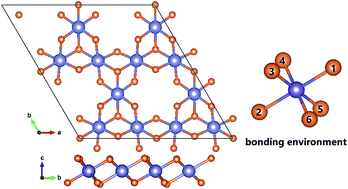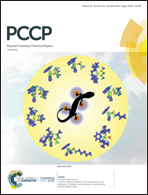Intrinsic magnetism and biaxial strain tuning in two-dimensional metal halides V3X8 (X = F, Cl, Br, I) from first principles and Monte Carlo simulation†
Abstract
A novel family of two-dimensional (2D) crystalline metal superhalogens V3X8 (X = F, Cl, Br, I) with intrinsic magnetism was predicted using first-principles calculations in the framework of density functional theory (DFT). The calculation results show that the V3Cl8 monolayer is an intrinsic anti-ferromagnetic semiconductor (AFS) with an indirect bandgap of 0.086 eV at the PBE functional level, while the V3X8 (X = F, Br, I) monolayer exhibits a fascinating ferromagnetic half-metal (FH) property with 100% spin-polarization at the Fermi level. Such 2D materials possess robust dynamical stability as well as thermal stability at room temperature except for V3Br8. In addition, Monte Carlo simulations based on the Ising model with the classical Heisenberg model estimate a Curie temperature of approximately 77 K and 103 K for the V3F8 and V3I8 systems, respectively. Furthermore, we predict an extraordinary phenomenon induced by biaxial compressive strain from the ferromagnetic half-metal (FH) to the ferromagnetic semiconductor (FS) at 2% strain and then to the antiferromagnetic metal (AM) with the biaxial strain increasing up to about 6.3% in the 2D V3I8 monolayer. In the case of 2D V3F8, as the strain varies from −10% to 8%, a series of electronic and magnetic phase transitions of AFS–AM–FH–AFS will occur. These tunable magnetic and electronic properties of 2D halides originate from the competition between AFM direct nearest-neighbor d–d exchange and FM superexchange via halogen p states, which leads to a variety of magnetic states. The explored controllable magnetic properties, electronic properties and the high Curie temperature render the 2D V3I8 monolayer a promising candidate for applications in magnetic logic devices and strain sensor devices.



 Please wait while we load your content...
Please wait while we load your content...